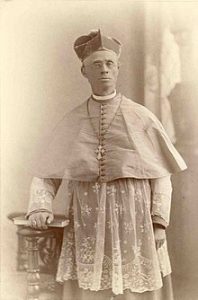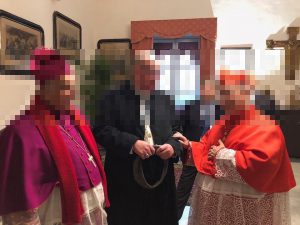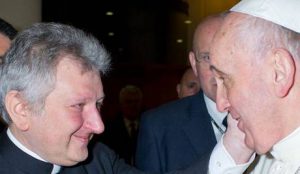Here are 10 very important Nota Benes to read before the account of homosexuality in the American Catholic Church:
1. This is not a gay-bashing blog-post. I have good friends who have struggled with same-sex attraction. Most of them were smart enough not to enter seminary or religious life. I say “smart” because it would be stupid to go live with 100 people you’re sexually attracted to for over seven years in a celibate vocation.
2. I do not believe anyone is born “gay,” so the correct Catholic term is actually “someone who struggles with same-sex attraction.” However, for the sake of brevity, I will often use the term “gay” or “homosexual.”
3. There have always been gays in the priesthood, but this blog post is a cultural evaluation of what is different about the 20th and 21st centuries. I know a 55 years old priest who claims that 60% of the priests his age are gay and 80% of the bishops are gay. The priest who told me this is a normal diocesan priest who does not even know the Traditional Latin Mass (TLM.) Many priests and seminarians from several dioceses concur on these admittedly-estimated numbers.
4. If you can show me any time in Church history with as many gays as the Catholic clergy in Europe and the Americas today, I will give you my vehicle, a 2007 Nissan Murano. You giving me numerous quotes from St. Peter Damien in the 11th century is not sufficient. In fact, the fact that we have only one saint repeatedly quoted on this topic from 19 centuries before our own proves to me that we have never had an epidemic of so many homosexuals in the priesthood as today.
5. Most priests and seminarians under 45 years old in the United States are straight, so things are getting better.
6. 80% of the cases of priests raping children came from priests (including now bishops and Cardinals) who self-identify as same-sex attracted. This was proven here.
7. Nevertheless, only 1.8% of priests are pedophiles as proven here.
8. This blog post is not about the child abuse in the clergy, but one of the many underlying perversions, namely, homosexuality in the priesthood. That is not the exclusive cause of criminal activity, but it is not a factor we can ignore.
9. This blog post is not about the full history of homosexuals in the priesthood, but rather the cultural factors and attacks on the Church in 20th century that created the perfect storm for many homosexuals to enter Catholic seminaries.
10. The next blog post after this one will have solutions to many of the below problems.
Jesus Christ chose twelve Apostles as His first Catholic bishops, half of whom were fishermen. Let that reality set in for a minute: Tough, blue-collar workers who never made it to rabbi-school were chosen as Apostles. To be sure, neither were they impious doofuses. They were tough, blue-collar workers who took their faith seriously, even when they had to say things to Our Lord like “Depart from me, for I am a sinful man, O Lord.”—Luke 5:8. They thought in black-and-whites like that, not Hegelian greys.
St. John the Baptist, although never chosen to be a Catholic priest, was of a Jewish priestly tribe. We know this because of what St. Luke tells us about the Baptist’s father, Zachariah: “And it came to pass, when he executed the priestly function in the order of his course before God, According to the custom of the priestly office, it was his lot to offer incense, going into the temple of the Lord.”—Luke 1:8-9. As you know, in Judaism, the son of a priest is always a priest.
Now, St. John the Baptist lived out his priesthood not in the Second Temple, but in the original temple of the cosmos, under the stars, in reflection of the first priest, Adam. That second temple in Jerusalem was built by King Herod, who’s son Herod who would one day kill St. John the Baptist for preaching against him taking his brother Phillip’s wife. But Herod was also rumored in Roman circles to be a vicious homosexual. Thus, by today’s standards, Herod was therefore a “bi-sexual” or “pan-sexual” since he also liked children.
In a little known passage from the Gospels, Jesus contrasts his saintly second-cousin John the Baptist to the filthy Herod who would one day kill the Baptist. St. Matthew writes: “As they went away, Jesus began to speak to the crowds concerning John: ‘What did you go out into the wilderness to see? A reed shaken by the wind? What then did you go out to see? A man dressed in soft clothing? Behold, those who wear soft clothing are in kings’ houses. What then did you go out to see? A prophet? Yes, I tell you, and more than a prophet.'”—Mt 11:7-8 ESV.
That word translated above “soft” in Greek is μαλακοῖς, and Jesus is saying that John the Baptist would never be caught in soft garments like rich kings. But the adjective μαλακοῖς (pronounced malakois) which is indeed accurately translated as “soft,” also has a very telling etymology. μαλακοῖς comes from the noun μαλακός (pronounced malakos) and my Greek-English dictionary defines it as this: “μαλακός—soft, soft to the touch, metaph. in a bad sense, effeminate, of a catamite, of a boy kept for homosexual relations with a man, of a male who submits his body to unnatural lewdness, of a male prostitute.”
If you doubt that this interpretation is a simply a stretch to include homosexuality in my blog post, look at which word the Apostle Paul uses to show how practicing homosexuals will not make it to heaven: 1 Cor 6:9: “Or do you not know that the unrighteous will not inherit the kingdom of God? Do not be deceived: neither the sexually immoral, nor idolaters, nor adulterers, nor men who practice homosexuality (μαλακοὶ), nor thieves, nor the greedy, nor drunkards, nor revilers, nor swindlers will inherit the kingdom of God.”—1 Cor 6:9-10. Notice that μαλακοὶ is the plural for effeminate men.
In his section on effeminacy in the Summa Theologica II-II.138, St. Thomas Aquinas writes, “It is inconsistent for one who is not cast down by fear, to be defeated by lust, or who has proved himself unbeaten by toil, to yield to pleasure.” In other words, St. Thomas is saying that the man “unbeaten by toil” is not likely to be effeminate. Unfortunately, the homes of modern bishops are more like those of Herod, than the rough tree-canopy of John the Baptist at the Jordan River.
Similarly, up until the 20th century, the priesthood was known as the most difficult life that a Catholic man could live. We all know of the constant physical pain felt by the first missionaries to the United States, like the Jesuit St. Isaac Jogues or the Franciscan St. Junipero Serra. St. Isaac Jogues had his fingers chewed off by Iriquois in upstate New York. St. Junipero Serra walked from central Mexico to southern California after being stung on his heel by a scorpion…all to establish missions up and down the California coast.
People expect this from old-school Jesuits and Franciscans, but did you know that bishops in the 19th century led lives as physically challenging? The first bishop of Colorado, Bishop Machebeuf, swept up and down the front range (modern day I-25) from Santa Fe to Denver and then back again, establishing missions, fighting off bands of bandits, mountain lions and bears…sleeping in tents, eating little, exposed to the New Mexico heat and the Colorado cold.

Bishop Machebeuf left France for this challenge in the 19th century and went everywhere with two priests. It was a hard life that only the toughest Catholic Frenchmen could endure. Colorado’s first parishes established by this first bishop of Colorado, Bishop Machebeuf, came at the price of his own body being racked by constant pain…yet it left him a humble demeanor and an excellent sense of humor. Only the toughest athletes of Europe could come be priests in the United States, be it religious or diocesan.
Before Vatican II, there was already a small infiltration of homosexuals and communists into seminaries and religious orders in the United States and Europe. In the 1960s, a French nurse named Marie Carre took care of a man in a horrible car accident. She found in his briefcase nearly-unbelievable evidence that the communists had placed 1100 men into Western seminaries for ordination, and they had made it to ordination undetected. The man who died in that car accident was one of them, and the findings of that mysterious briefcase are in this book. The point is that the infiltration of the priesthood of communists, gays and freemasons began sometime in the 20th century significantly before Vatican II.
Remember that the point of this blog post is simply to show how the culture and the Church changed to allow more gays into the priesthood than ever before. Also, remember that although this blog post is not about the raping of children, Nota Bene number six at the beginning of this blog post shows that 80% of the priests who harm children were identified as gay. Part 2 will be solutions.
Catholicism grows very well in pain and opposition. But by the time John F. Kennedy was President of the United States, Catholics were no longer sidelined, but rather mainstream. Fighting side-by-side with Protestants in two World Wars earned us the respect as equals, as true American citizens. Of course, the Irish Catholic President Kennedy greatly promoted the cause of Catholic popularity in both the United States and Europe. This is fine too, but it presents a small problem: It it is hard to be faithful when things get easy as a Catholic. As the Clear Creek translation of the Bible says, “The beloved have become fat and frisky.”—Dt 32:15.
.
The bishop in the middle is straight, but I learned as a priest that that gentle elbow grab with a goofy smile is usually a good sign the cleric is struggling with same sex attraction. I mean—not struggling.
Thus, Catholics (and especially priests and bishops) went from unpopular and poor in the 19th century to popular and rich after the second World War. It came to be that if you want to live in a million-dollar rectory just for offering one Mass a day but you don’t want to tell your mother why you don’t like women, then the Catholic priesthood might be right for you! As if this was not a perfect storm enough, then Vatican II arrived. For nearly 40 years before Vatican II, there was a small creep of modernism, homosexuality and even communism into seminaries in North America and South America. Vatican II was not the root of such men in the Church, but they certainly hijacked the original documents of the Council in the second week of October 1962.
The decade that followed Vatican II was not the genesis of gay priests, but it allowed them to live in the open, and here’s my guess as to why: All through seminary, I was told that there was no change to liturgy or doctrine. Vatican II had just been mis-implemented. I repeated this odd mantra, and somehow I got ordained. So, I arrive in the parish, and I do the Mass of Vatican II according to the rules of Vatican II as faithfully as I could. Then, I sadly had five parishes in five years, repeatedly getting booted for disallowing careless so-called “Extraordinary Ministers of Holy Communion.” (Only one of those pastors was probably gay, thankfully.)
But still, I would always end up in the bishop’s office quoting a 2004 document, Redemptonis Sacramentum, against this and countless other abuses. At the end of five years, I had been kicked out of five parishes, and I was exhausted. If I expected my reader in previous blog posts to pity me for having so many parishes, I now write this to prove a simple point: If a priest is not allowed to do the Mass of Vatican II according to the rules of Vatican II in a conservative diocese, under five conservative pastors…then there is no order to the Novus Ordo.
Let me write that again with no exaggeration: Even in conservative dioceses, there is no order to the Novus Ordo liturgy. This means the Mass of Vatican II was not just mis-implemented. It was written to have no order. The Dutch, Dominican Father of Vatican II, Fr. Edward Schillebeeckx said: “We have used ambiguous phrases during the Council and we know how we will interpret them afterwards.”—Fr. Schillebeeckx.
Mission Accomplished, Fr. Schillebeeckx! Many if not most American dioceses have at least one young, straight priest who has been suspended from offering public Masses not because he did the Traditional Latin Mass, but because he did the Mass of Vatican II according to the so-called “rules” of Vatican II. But as Fr. Edward Schillebeeckx admitted, the ambiguity of the Mass of Paul VI was ultimately for chaos in the rules. This does not come from me, but from one of the main players of Vatican II.
This also proves there is no “hermeneutic of continuity” even in conservative dioceses. This is not only a problem in liturgy, but also doctrine. In my first five Novus Ordo parishes, I was certainly allowed to preach the True Presence of Christ in the Eucharist and I was even allowed to preach pro-life, but anything else that came from the doctrine of Catholic tradition, and I was frequently told that I was not “pastoral.” What kind of men are going to be attracted to a no order system of doctrine like that? What kind of men are going to be attracted to a liturgy that puts entertainment ahead of liturgical precision? What kind of men are going to be attracted to popularity ahead of doctrinal precision? There’s only one answer to all three questions: Homosexuals.
A no-order liturgy and a no-order doctrine are going to attract a man who is aberrantly-ordered sexually. It’s really very simple. The Mass of Vatican II and the amorphous teaching of the last fifty years on doctrine is very attractive to manipulative and emotional men, and such personality traits are always correlative to same-sex attracted men. It is a lot easier since I now offer only the Traditional Latin Mass.
What happened to the straight men who were attracted to solid, doctrinal parameters? They were kicked out of seminaries in the 1990s. A man who does not believe in any objective order for his sexuality (homosex at best, child abuse at worst) is going to be attracted to a Mass where he, the narcissist, is the only point of reference for entertaining the people. Furthermore, unrepentant gay men prefer the fuzzy doctrine of the post Vatican II era, for here, every rule can be dispensed for “pastoral reasons.”
Once the gay, conniving manipulative priests began to fill seminaries and religious orders in the 1970s, they easily became priests by the 1980s, and then bishops by the 1990s. To prove that gay bishops ambitiously helped each other in ladder-climbing through the hierarchy would take another five blog posts. Always follow the money. Oh, and follow the sex: As we saw in the Cdl. McCarrick history, the gay hierarchy purposefully sought out soft or handsome young men (and even boys) to enter their seminaries for untoward reasons. “Conservative” orders like the Legionnaires of Christ were simply smoother about their destruction of the priesthood than the liberals. It should be noted that this gay perversion and child abuse has even made it a little bit to certain traditional religious congregations that use the Traditional Latin Mass. Joseph Sciambra reported abuse of children in the traditional Society of St. John decades ago. He was not fully vindicated until the last chapter of the recently-released 2018 Pennsylvania Grand Jury Report on the Society of St. John.
Why don’t current, young orthodox priests blow the whistle on this gay mafia? Because most of the straight guys become cowardly, company men under their gay superiors, even when they avoid sexual sins with them. Occasionally one priest or another has the fortitude to blow the whistle.

Msgr. Ricca was a Vatican diplomat posted in Montevideo, Uruguay and has made secular international news many times for homosexual scandals. Ricca was later later named as “head of the Papal residence” at the Casa Santa Martha.
Finally, realize that the necessity of gay men running parishes jives very well with an America where women are the spiritual leaders of the families. Although I blame these scandals entirely on priests, not on families, we must recognize that the breakdown of the family contributed to such rotten priests. Catholic boys for the past fifty years have mostly been raised by their mothers, not their fathers. This has partly contributed to a mostly-gay priesthood. These gay priests furthermore surround themselves with old women in the parish, to whom they give much control. It’s a symbiotic relationship: The gay priest gets to gossip over coffee with the ladies all morning. In return, the ladies are delegated control of a parish—the next best thing to getting ordained.
In the next blog post, I’ll offer some possible but real solutions to re-establishing a straight, healthy and strong priesthood in the Catholic Church.
